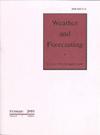A Comparison of Right-Moving Supercell and Quasi-Linear Convective System Tornadoes in the contiguous United States 2003–2021
IF 3.1
3区 地球科学
Q2 METEOROLOGY & ATMOSPHERIC SCIENCES
引用次数: 0
Abstract
Tornadoes produced by right-moving supercells (RM) and quasi-linear convective systems (QLCS) are compared across the contiguous United States for the period 2003–2021, based on the maximum F/EF-scale rating per hour on a 40-km horizontal grid. The frequency of QLCS tornadoes has increased dramatically since 2003 while the frequency of RM tornadoes has decreased during that same period. Prior work noting that the most common damage rating for QLCS tornadoes at night is EF1 persists in this larger, independent sample. A comparison of WSR-88D radar attributes between RM and QLCS tornadoes shows no appreciable differences between EF0 tornadoes produced by either convective mode. Differences become apparent for EF1–2 tornadoes, where rotational velocity is larger and velocity couplet diameter is smaller for RM tornadoes compared to QLCS tornadoes. The frequency of tornadic debris signatures (TDS) in dual polarization data is also larger for EF1–2 RM tornadoes when controlling for tornadoes sampled relatively close to the radar sites, and during daylight versus overnight. The weaker rotational velocities, broader velocity couplet diameters, and lower frequencies of TDSs both close to the radar and at night for QLCS EF1 tornadoes suggest that a combination of inadequate radar sampling and occasional misclassification of wind damage may be responsible for the irregularities in the historical record of QLCS tornado reports.2003–2021年美国邻近地区右移动超级单体和准线性对流系统龙卷风的比较
根据40公里水平网格上每小时的最大F/EF等级,对2003年至2021年期间美国各地由右移超级单体(RM)和准线性对流系统(QLCS)产生的龙卷风进行了比较。自2003年以来,QLCS龙卷风的频率急剧增加,而RM龙卷风的频率在同一时期有所下降。先前的工作指出,QLCS龙卷风在夜间最常见的破坏评级是EF1,这在这个更大的独立样本中仍然存在。RM和QLCS龙卷风之间WSR-88D雷达属性的比较表明,由任一对流模式产生的EF0龙卷风之间没有明显差异。EF1–2龙卷风的差异变得明显,与QLCS龙卷风相比,RM龙卷风的旋转速度更大,速度耦合直径更小。当控制相对靠近雷达点采样的龙卷风时,EF1–2 RM龙卷风的双极化数据中的龙卷风碎片特征(TDS)频率也更高,白天与夜间相比。QLCS EF1龙卷风在雷达附近和夜间较低的旋转速度、较宽的速度联接器直径和较低的TDS频率表明,雷达采样不足和偶尔对风损的错误分类可能是QLCS龙卷风报告历史记录不规则的原因。
本文章由计算机程序翻译,如有差异,请以英文原文为准。
求助全文
约1分钟内获得全文
求助全文
来源期刊

Weather and Forecasting
地学-气象与大气科学
CiteScore
5.20
自引率
17.20%
发文量
131
审稿时长
6-12 weeks
期刊介绍:
Weather and Forecasting (WAF) (ISSN: 0882-8156; eISSN: 1520-0434) publishes research that is relevant to operational forecasting. This includes papers on significant weather events, forecasting techniques, forecast verification, model parameterizations, data assimilation, model ensembles, statistical postprocessing techniques, the transfer of research results to the forecasting community, and the societal use and value of forecasts. The scope of WAF includes research relevant to forecast lead times ranging from short-term “nowcasts” through seasonal time scales out to approximately two years.
 求助内容:
求助内容: 应助结果提醒方式:
应助结果提醒方式:


